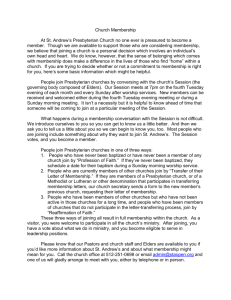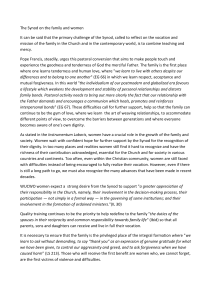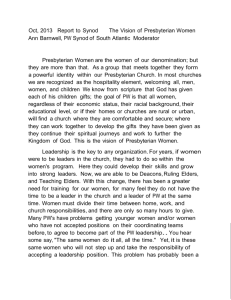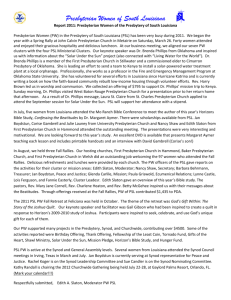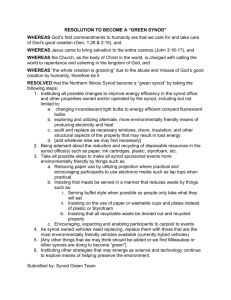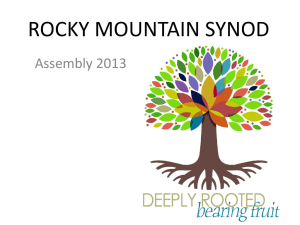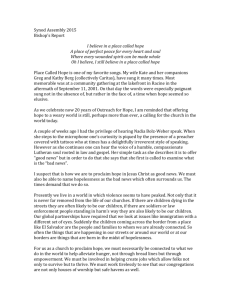IMPRESSIONS FROM THE HISTORY OF THE PRESBYTERIAN
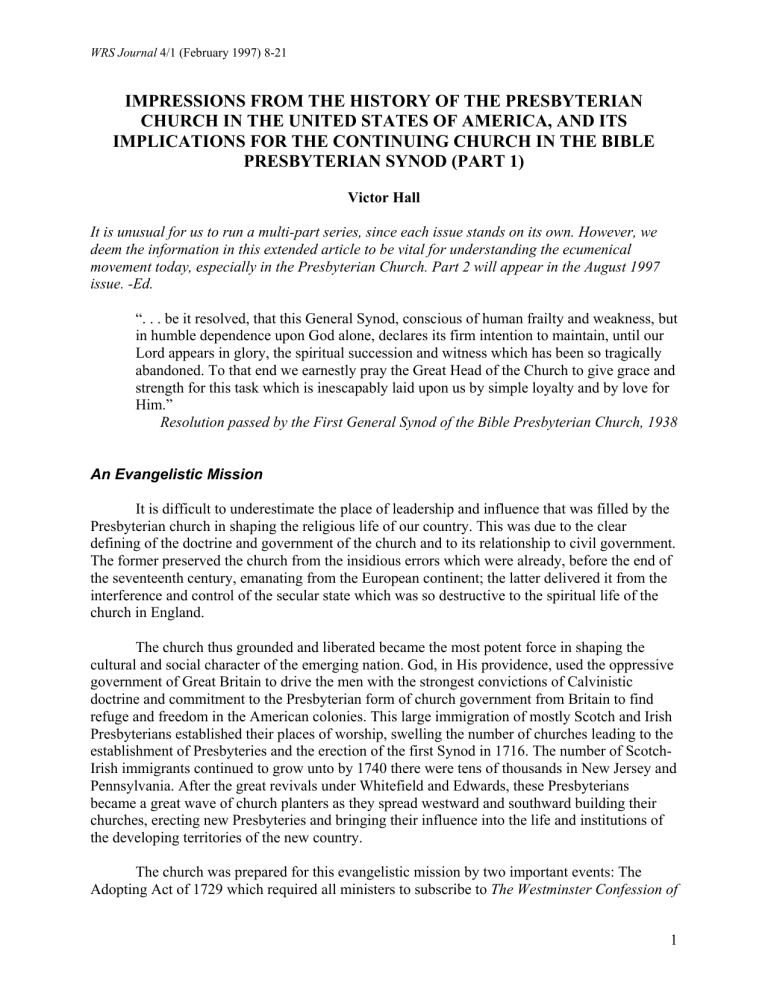
WRS Journal 4/1 (February 1997) 8-21
IMPRESSIONS FROM THE HISTORY OF THE PRESBYTERIAN
CHURCH IN THE UNITED STATES OF AMERICA, AND ITS
IMPLICATIONS FOR THE CONTINUING CHURCH IN THE BIBLE
PRESBYTERIAN SYNOD (PART 1)
Victor Hall
It is unusual for us to run a multi-part series, since each issue stands on its own. However, we deem the information in this extended article to be vital for understanding the ecumenical movement today, especially in the Presbyterian Church. Part 2 will appear in the August 1997 issue. -Ed.
“. . . be it resolved, that this General Synod, conscious of human frailty and weakness, but in humble dependence upon God alone, declares its firm intention to maintain, until our
Lord appears in glory, the spiritual succession and witness which has been so tragically abandoned. To that end we earnestly pray the Great Head of the Church to give grace and strength for this task which is inescapably laid upon us by simple loyalty and by love for
Him.”
Resolution passed by the First General Synod of the Bible Presbyterian Church, 1938
An Evangelistic Mission
It is difficult to underestimate the place of leadership and influence that was filled by the
Presbyterian church in shaping the religious life of our country. This was due to the clear defining of the doctrine and government of the church and to its relationship to civil government.
The former preserved the church from the insidious errors which were already, before the end of the seventeenth century, emanating from the European continent; the latter delivered it from the interference and control of the secular state which was so destructive to the spiritual life of the church in England.
The church thus grounded and liberated became the most potent force in shaping the cultural and social character of the emerging nation. God, in His providence, used the oppressive government of Great Britain to drive the men with the strongest convictions of Calvinistic doctrine and commitment to the Presbyterian form of church government from Britain to find refuge and freedom in the American colonies. This large immigration of mostly Scotch and Irish
Presbyterians established their places of worship, swelling the number of churches leading to the establishment of Presbyteries and the erection of the first Synod in 1716. The number of Scotch-
Irish immigrants continued to grow unto by 1740 there were tens of thousands in New Jersey and
Pennsylvania. After the great revivals under Whitefield and Edwards, these Presbyterians became a great wave of church planters as they spread westward and southward building their churches, erecting new Presbyteries and bringing their influence into the life and institutions of the developing territories of the new country.
The church was prepared for this evangelistic mission by two important events: The
Adopting Act of 1729 which required all ministers to subscribe to The Westminster Confession of
1
WRS Journal 4/1 (February 1997) 8-21
Faith, and the great revivals, generally known as “The Great Awakening” of 1740-45. The former erected the walls guarding the doctrinal standards and integrity of the ministry and perhaps even more importantly setting the agenda for the religious training in the schools that were to be established as the church spread throughout the advancing frontier. The latter event, the great revivals, awakened a renewed devotion to the duties of godly living and a zeal for winning the lost to Christ.
This preparation was not without its opposition. There were some who objected to the
Adopting Act saying that “Such required subscription [to the Westminster Confession] was a violation of the right of private judgment [conscience] and inconsistent with Christian liberty and true Protestantism.” 1 Others feared it would be divisive, requiring a narrow view of Christian doctrines to which many could not subscribe, and objected on that ground. It required two full years prior to adoption of the Confession to allay the fears and overcome opposing arguments and then, after the adoption in 1729, it required seven more years of discussion to overcome the scruples and questions of some and gain full support of the Presbyteries. In regard to “The Great
Awakening,” disagreement over welcoming and participating in it ultimately led to an open schism that lasted 17 years (1741-1758). Such was the travail of our forefathers which ultimately resulted in the establishment and propagation of a truly Presbyterian church in the United States of America.
This was the church that was to provide the dominant leadership in the establishment of a great part of the most influential and prestigious religious and cultural institutions of our early history. Benjamin Rice Lacy, Jr., in his book Revivals in the Midst of the Years, quotes a historian of Old Redstone Presbytery as stating, as concerning the early Scotch-Irish Presbyterian immigrants and their sojourn in Eastern Pennsylvania and New Jersey,
A sublime mission for them and their children was intended, though altogether concealed from their view. They were not yet prepared for that mission. They must receive that preparation through the great revival under Whitefield, the Tennents, the Blairs, and a host of others, whom God raised up in the earlier parts of [the eighteenth century], to be instruments in His hands of spreading a new life through the church.
Dr. Lacy then adds,
As in 1625 [year of a great revival among Presbyterians in Ireland] so now the fire fell and religion flamed again in Scotch-Irish hearts, and men and families were rededicated to God before they began the long trek down the valleys of Pennsylvania, through the valleys of Virginia, to the valleys of the Catawba and the Yadkin, to the Waxhaw settlement in South Carolina, and into the hill country of North Georgia. They went to establish churches and schools and Presbyteries as well as homes.
The Dominance of Calvinism
It is true there were other church bodies in the colonies during this time of early development. However, the relatively strict regulation religious suffrage permitted to the settlers
2
WRS Journal 4/1 (February 1997) 8-21 in the colonies was limiting factor keeping the Protestant denominations to a small number. The only denomination of large enough numbers and wide enough distribution to make a significant contribution and which was not Calvinistic in doctrine was the Church of England, or Episcopal
Church, which opposed the revival and did not participate. The Congregational churches in New
England were thoroughgoing Calvinists with many of them leaning toward Presbyterianism.
There were also the Dutch, German, and French Calvinists but all except the latter kept pretty much to themselves while the French, for the most part, ultimately merged into the Presbyterian and Anglican folds.
This dominance of Calvinism was almost complete in the churches that participated in the revivals of “The Great Awakening.” Thus the doctrines that were preached, during this time of the great outpouring of God’s Spirit upon His church in the American colonies, were thoroughly Calvinistic and those who were converted were added to these Calvinistic churches or, in many cases, started new churches propagating the Reformed faith. The Presbyterian church had two advantages in this situation. The first was that the most effective and prominent ministers closely associated with Whitefield were the Tennents, Finley, and the Blairs, along with others— for the most part Presbyterians. These men were much in demand to preach in all parts of the country; and the doctrines of Whitefield, as well as these men, were Calvinistic
Presbyterian doctrines, although he was ordained in the Episcopal church. Thus Calvinist doctrine is what these churches had been taught, convinced of, and what they desired. The second was that the Presbyterian form of government facilitated a concerted effort to train and deploy ministers to fill the demands of the many new churches needing pastors. It is a thrilling experience to read excerpts from the Presbyterial and Synodical records of the period immediately following the revival as they are given to us by Charles Hodge in his Constitutional
History of the PCUSA.
These records are filled with accounts of the Presbyteries and the Synod sending their ministers on two, three, or six months preaching tours to minister to the many new churches springing up in new areas of the frontier country who were without ministers. In fact, the demand for ministers was so great that the Presbyteries could not produce enough trained men, and this resulted in a great number of these churches being picked up by the Baptists and the Methodists who did not require such high standards for their ministers. Thus these two denominations, which were quite small before the “Awakening,” grew greatly by these acquisitions and became a major presence in the frontier territories of the Midwest and the South.
The Log College
An equally important factor in shaping the character and the direction of the Presbyterian church in this country was the founding of the “Log College” by William Tennent in 1726. This marked the beginning of the Presbyterians in America to assume the responsibility for training young men and equipping them for the gospel ministry in their churches. This was an essential move if the church was to be kept on its doctrinal course and to fulfill its God-given mission in the expanding colonies. The contribution of this institution to the shaping of the nature and development of the Presbyterian church in this country is perhaps one of the least known and appreciated facts of American Presbyterian history.
William Tennent, Sr. seemingly founded the “Log College” without consultation or the
3
WRS Journal 4/1 (February 1997) 8-21 cooperation of others in the Synod. There is no mention of any discussion of any effort to found such a school except for that which was made at New London by the Old Side Synod, at a later date. There is no indication either by Hodge or Baird of any mention in the Presbyterial or
Synodical records of any discussion regarding the College under Mr. Tennent at Neshaminy. In fact, Archibald Alexander, in his book, The Log College, reveals much evidence that Tennent’s school was greatly disparaged and opposed by some of the men in the Old Synod. Thus it would appear that it was an entirely independent undertaking rising as a result of his sense of the paramount need of emerging communities and churches destitute of qualified men to minister the
Word of God. It should be noted that the founding of this institution as a means to meet this need demonstrated a conviction that the work of God cannot be done by and must not be entrusted to unqualified men. An examination of the preaching and writings of these men reveals a thorough understanding of Reformed theology and the disciplines of a sound liberal education. Nothing that has been written of the men graduated from this institution has successfully established any evident to disprove this. In fact, there is no know serious attempt to do so. Gilbert Tennent, whose education was received entirely under the teaching and supervision of his father, was thorough and uncompromising in his insistence upon strong academic standards with a strict adherence to both the system of doctrine and the form of government set down in the
Westminster Confession of Faith with its attending Directory of Church Order. This is documented by Charles Hodge in his Constitutional History.
Dr. Hodge documents quite clearly, in dealing with the history of the schism of 1741-1758, that there was no difference as to adherence to the doctrines set down in the Confession of the form of government required in the
Directory between the Old Side, constitution the old Synod, and the New Side, led by men associated with the College. Yet the College was much involved in the issues that brought about the schism. Indeed, the fear of division over the issues, pressed by the Old Side men, in behalf of the Adopting Act was ultimately realized in the issues, pressed by men and friends of the Log
College, in behalf of the revival.
When we seek to find what, in the College’s teaching or practice, precipitated the straining of relationships and ultimate division in the Synod, two things stand out. The emphases of the school seemed to develop outstanding qualities of godly piety of personal life and zeal for evangelism in its students. There is ample recorded testimony from their contemporaries, both friends and foes, to establish that there was a dominant manifestation of these qualities of piety and zeal in the lives of these men of the College. Both Charles Hodge and Samuel Baird thoroughly debunk any suggestion that there is any evidence of self-righteousness or hypocrisy in the bearing or attitude of these men. They were sincere, godly, self-sacrificing ministers. Still it was the presence of these qualities that ultimately precipitated the division.
In connection with this issue which so divided the church at this time, we must consider two things. First, the part played by the Log College in the Great Awakening and second, the place of the Great Awakening in the plan and purpose of God for the church in the emerging republic in the thirteen colonies. First, let us consider the latter from our perspective in time, and we must begin by considering the effect of the great revivals upon the church of that period of our history. Dr. Lacy, in his history of the revivals says,
He who designated the religious movement in the colonies during the eighteenth century as ‘The Great Awakening’ had a touch of genius. It was for America an awakening of
4
WRS Journal 4/1 (February 1997) 8-21 dead churches and the calling of many sinners from death unto life.
In this quotation, we have a rather unfavorable assessment of the church that for love and zeal for sound doctrine and its concern to assure its preservation from corrupting influences had presevered through nine years of controversy and earnest debate to secure the adoption of the
Westminster Confession of Faith making it mandatory as the personal confession of every minister throughout the entire Synod.
This, perhaps surprising, assessment for the state of the spiritual condition of this sound, militantly Calvinistic church is also the assessment of some of its most respected leaders of that time. Samuel Blair, in a letter to the Rev. Mr. Prince in Boston dated August 6, 1744, declares concerning the state of the church just prior to and at the beginning of the revivals,
I doubt not then but there were some sincerely religious people up and down; and there were, I believe, a considerable number in the several congregations, pretty exact, according to their education, in the observance of the external forms of religion, not only as to attendance upon public ordinances on the Sabbath, but also as to the practice of family worship and, perhaps, secret prayer; but with these things the most part seemed to all appearance to rest contented, and to satisfy their consciences with a dead formality in religion.... The nature and necessity of the new birth was but little known or thought of.
The necessity of a conviction of sin and misery by the Holy Spirit opening and applying the law to the conscience, in order to a saving closure with Christ, was hardly known at all to the most.... There was scarcely any suspicion at all, in general, of any danger of depending upon self-righteousness, and not upon the righteousness of Christ alone for salvation.... The common notion seemed to be that if people were aiming to be in the way of duty as well as they could, as they imagined, there was no reason to be much afraid....
People were very generally, through the land, careless at heart, stupidly indifferent about the concerns of eternity.... It was sad to see with what careless behavior the public ordinances were attended.... Thus religion lay, as it were adying, and ready to expire its last breath of life in this part of the visible church.
This same quotation is cited by Charles Hodge in his description of the condition of the church at that time. This is a contemporary description of the spiritual condition that prevailed in the Presbyterian Church less than four years after the protracted struggle that successfully secured through the Adopting Act, the safeguarding, and assurance of the purity, of the doctrines that would be preached and taught in her pulpits. Deadness with orthodoxy may be just as tragic and fatal as zealous heresy.
The church, though orthodox and zealous for the truth, was woefully lacking in that which was equally essential; namely, that personal experience of Christ’s redeeming love that would send her forth with compassionate hearts to seek lost souls, suffering in misery and enslavement to sin, and to seek to bring them to Christ. This was the preparation which she was, as stated by the historian of Old Redstone Presbytery,
...to receive through the great revival under Whitefield, the Tennents, the Blairs, and a host of others whom God raised up...to be instruments in His hands of spreading a new
5
WRS Journal 4/1 (February 1997) 8-21 life through the church.
Dr. Hodge demonstrates through the written testimony of godly men who were contemporaries of the revival and its aftermath that the evidences produced by the Great Awakening were evidences of genuine revival. It resulted in the salvation of thousands who gave evidence of their conversion by continuing in holy lives and fruitful service for Christ; saints were awakened to new devotion, churches were revitalized and filled with a new desire and purpose to spread the gospel. Dr. Hodge states in his evaluation of the genuineness and effectiveness of the revival,
“To the Presbyterian Church particularly, it was the commencement of a new life, the vigor of which is still felt in all her veins.”
We can see the hand of God in the foundation of the Log College in preparation for the revival. It was here that the men would be equipped who were to prepare the middle colonies, much as Edwards did in New England, for the coming of Whitefield and the outpouring of the
Spirit that God would graciously give under his ministry. These men of the Log College were closely associated with Whitefield in the Awakening and became not only the evangels to spread the flame to all parts of the church during its course but to continue on after the Awakening to become the tireless perpetrators of its benefits throughout the growing church as it spread into the developing new territories to the South and West. Dr. Lacy again says, “...in reality our church [the Presbyterian Church in the South] was reborn through this movement.” All church historians of this period of the aftermath of the Awakening give testimony to the indefatigable labors of these graduates and friends of the College as they toiled to establish the new converts, minister the Word of God among the many churches without “settled pastors” and establish new congregations in every part of the spreading frontier.
Thus the church, grounded in sound doctrine and quickened by the Spirit of God, through the adoption and strict adherence to the Westminster Confession of Faith, was prepared to be the instrument in God’s hands to spread the gospel and plant sound churches in every part of the nation soon to be born on these shores. Without either aspect of this preparation, the church would have been weak and disastrously ineffective. Without the permanent foundation of the
Westminster Confession, through the persistence of the Old Synod and the resultant Adopting
Act, the church would have been unstable and soon fallen into apostasy, division, and false teaching. Without the baptism of evangelistic fervor supplied by the Log College, its graduates, and friends, the church would have stagnated in complacent formality. The history of the New
England churches exemplifies the former while the history of the Old Side Synod during the schism of 1741 to 1758 exemplifies the latter. We see, through the circumstances of the controversy, schism, and ultimate reunion, God’s hand supplying and equipping the church for
His purpose.
The Seeds of Schism
It is profitable for us to consider examples of history from which we may learn something of human frailty and God’s sovereignty. We may from our viewpoint wish the schism had never happened. Indeed, the need for the revival is quite clear; also, the need for doctrinal zeal and vigilance is equally vital. Perhaps if there had been more temperance and less impetuosity on the
6
WRS Journal 4/1 (February 1997) 8-21 part of the New Side men and more patience and meekness on the part of the Old Side men, this problem could have been solved with harmony. However, under God’s sovereign intervention, both of these needs were met and unity was ultimately restored in the reunion of 1758. Hodge, in his History , gives a great deal of space to demonstrate that doctrine was not neglected in the revival but prominently proclaimed and the doctrines were sound Calvinistic doctrines. Dr.
Hodge says,
Is there any doubt as to the doctrines taught by Whitefield, the Tennents, Blair, Dickinson and the other prominent preachers of that day? They were the doctrines of the
Reformation, and of the standards of the Presbyterian Church. Indeed, these men often went to a length in their statements of the peculiarities of those doctrines, that would shock the delicacy of modern ears. These great truths were not kept under a bushel during this period. The doctrines preached by those famous men, who were owned as the principal instruments of this remarkable revival of God’s work, were the doctrines of the reformers; the doctrine of original sin, of regeneration by the supernatural influences of the divine Spirit, and of the absolute necessity of it, that any man might bear good fruit, or ever be admitted into the kingdom of God; effectual calling; justification by faith, wholly on account of the imputed righteousness of Christ; repentance towards God and faith towards our Lord Jesus Christ; the perseverance of the saints; the indwelling of the
Holy Spirit in them, and its divine consolations and joys.
Thus sound doctrine was preserved through the revival and reunion was possible to the divided church. This certainly reveals the fallacy of the often heard contention that doctrine is divisive and stifles revival.
One contributing cause to the schism in 1741 seems rather scantily noticed and may only be perceived by relating several rather random references from different sources. It is mentioned by both Baird and Hodge in their Histories of this period but neither of them seems to assign it a really significant role and yet a serious reflection on subsequent events would seem to indicate it may have had a far more significant role than even those of that time would openly indicate. The
Log College was the first literary institution of higher education to be founded in the bounds of the Presbyterian Church. The Presbyterian Church, up to this time, had been dependent on ministerial supplies for the most part from Scotland or Ireland. There were some few occasional men who came from England of Wales. There had been colleges established in New England during the middle and latter part of the seventeenth century and this was accomplished with a high degree of participation with the Congregationalist churches in those colonies. Thus the
Presbyterians on these shores were relying for their supply of ministers generally to come from
Ireland, Scotland, or one of the colleges of New England. This constituted a hardship and a hindrance to the development and growth of the Presbyterian Church in America.
It was into this situation that the Log College was introduced. William Tennent, Sr., its founder, was, himself, a native of Ireland where he received his liberal education, though from which college or university it is not certain, but very likely from Trinity College in Dublin as he originally belonged to the Episcopal Church of England. Not a great deal about Mr. Tennent or the details of his leaving the Episcopal Church to embrace the doctrines and for of government of the Presbyterians is known. He was originally ordained a priest in the Episcopal Church. He
7
WRS Journal 4/1 (February 1997) 8-21 became acquainted with a distinguished Presbyterian minister, Rev. Mr. Kennedy, in Ireland, who, because of great persecution that arose in Great Britain against Presbyterians, moved and exercised his ministry with “great success” in Holland. William Tennent married one of Rev. Mr.
Kennedy’s daughters and they emigrated to America in 1716. He was closely examined by the
Synod of Philadelphia regarding his doctrines and reasons for leaving the Church of England, and fully satisfied them with his answers and was received into the membership of that Synod.
After residing for some time in New York, Mr. Tennent received a call to serve a small congregation at Bensalem in Pennsylvania. He served in this place until 1726 when he accepted a call to Neshaminy in the same county of Pennsylvania where he erected the Log College during the same year and there he ministered for the rest of his life. There is nothing written of the details of the founding of this school, nor is there any record of the reasons for which Mr.
Tennent felt moved to his course. We may look only at the conditions which prevailed in the church at that time, what emphases were evidenced by the College and the character and ministries of its graduated. From these we may glean some indication of the purpose of its founder.
Archibald Alexander describes the condition of things in the Presbyterian Church at this time. He says,
...the state of vital piety was very low in the Presbyterian Church in America.... The ministers composing the Presbyterian Church in this country were sound in the faith, and strongly attached to the Westminster Confession of Faith and Catechism, as were also the people; and there were no diversities or contentions among them respecting the doctrines of the gospel; but as to vital power of godliness, there is reason to believe that it was little known or spoken of.... Indeed, it was very much a matter of course for all who had been baptized in infancy to be received into the communion at the proper age, without exhibiting or possessing any satisfactory evidence of a change of heart by the supernatural operations of the Holy Spirit. And the habit of preachers was to address their people as though they were all pious, and only needed instruction and confirmation.
This, of course, agrees with the description given by Samuel Blair and others cited elsewhere. Whatever Mr. Tennent felt and thought concerning this state of affairs in the church at this the time when he came into it as a minister, he seems to have kept it to himself. There is no record of any discussions he had with others, in or out of the Synod, about it. Nevertheless, from subsequent differences over the emphases and zeal of its graduates, it would appear that he had a concern to address these problems in the church and infuse new life into its ministry.
Several men had been graduated from the College and gained admittance to the Synod before the controversy over its ministry arose. It is admitted that they were all sound in their
Calvinistic Presbyterian doctrine, they exhibited exemplary piety in their personal lives, and the blessing of God was evident in their ministries; it was objected, however, by many in the Synod that in certain branches of learning not related to theology they were not up to the standards of the European and New England colleges and they did not want to admit them into the Synod, judging them unqualified.” They could hardly have objected that the College was deficient in the classics. Archibald Alexander, quotes Elias Boudinot, a highly respected man of letters and a
8
WRS Journal 4/1 (February 1997) 8-21 contemporary of Mr. William Tennent, as stating that Tennent
...was well skilled in the Latin language, that he could speak and converse in it with as much facility as in his vernacular tongue, and, also, that he was proficient in the other ancient languages.
The writer of a sketch of William Tennent, Sr.’s life in the Assembly’s magazine for May, 1805, says regarding Tennent, “He was eminent as a classical scholar.”
In 1738 they enacted a rule requiring that all candidates applying to a Presbytery for licensure and admission who had not first received a diploma from some European or New
England college must apply to the Synod and be approved by it before being received by the
Presbytery. This is a rather surprising act of the Old Synod seeing that they had already much evidence that doctrinal error had gained foothold in some of the European (including Scotch and
Irish) schools and some of the New England schools had become seriously affected by false teaching (notably Harvard, though Yale followed soon after in the latter part of the eighteenth century). It seems there was a strange lack of discernment of this danger and an inordinate regard for some of the sciences which they professed they found lacking in these Log College men whom all acknowledged to be thoroughly grounded in Calvinistic doctrine and godly piety in their personal lives.
The New Brunswick Presbytery had been erected shortly before this time by the Synod and was composed almost entirely of graduates or supporters of the College. This rejection of its credentials was a hard blow to these men. They objected that such a restriction on the
Presbytery’s jurisdiction over the examination of candidates in their Presbytery was improper and contrary to Presbyterian principle and an attempt to impose the will of the Synod upon a local Presbytery. Charles Hodge states in regard to Gilbert Tennent’s opposition to this act of the
Synod requiring ministerial candidates to have a degree from an European or some New England college, “Mr. Tennent’s opposition... did not arise from a disregard of learning, but from want of confidence in the existing colleges.” Might this not reveal a discernment in Mr. Tennent that was far in advance of his contemporary brethren? This same sympathy and benevolence toward the
“College” was shared by many members of the New Castle Presbytery and the New York
Presbytery. This contributed as much as any dispute over participation in the revival to the open rupture in the Synod and is noteworthy because of the strong influence that the College had on the subsequent development and history of the Presbyterian Church in the United States of
America.
The excising of the New Brunswick Presbytery, and with it the ministry of the College, brought an almost immediate awareness to the men of the Old Synod of the urgent need of a school for training young men for the ministry. Though they may not have been happy nor would they fully approve of the College, it had supplied a good portion of the most recent additions of men to the Synod. Now, it seemed as if a sudden new awareness struck them that there was no place for their young men to go. In consequence, they began now in earnest to establish a school under the guidance and support of the Synod. This effort started with the purpose of raising up a school in New London 1744 and this endeavor continued for several years during which time the operation was moved to Philadelphia. Various providential difficulties and hindrances, however,
9
WRS Journal 4/1 (February 1997) 8-21 kept them from realizing their purpose. God, it seemed, had other plans.
The college of New Jersey
The school which had performed such a needed service of the church in the early years of the Synod and which had a singular role in preparing the church for the Great Awakening was now, after the schism, waning. Mr. William Tennent, Sr. was aging and unable to exert his former vigor in conducting its affairs, but the Log College was about to enter a new phase of its influence and usefulness through the ministries and activities of its graduates who are all remembered with a high degree of veneration for their service in, and lasting effect upon, the development of the Presbyterian Church. These were men of great spiritual stature, thoroughly grounded in Calvinistic Presbyterian doctrine, committed to Presbyterian government and possessed of a zeal that was commensurate with the task of establishing and nourishing the church in every part of the rapidly developing colonies.
As the church advanced in its growth and development, it became evident that this humble institution which had performed such a noble task in the early years of the church was now inadequate for the greatly expanded need for more ministers. (The only description we have of the physical aspects of the Log College is a short reference in George Whitefield’s journals. It was an unrefined structure about 20’ x 20’. From this, it is clearly evident it could hardly accommodate more than a dozen scholars.) It should be noted that there was never a thought by the Presbyterians of either the New or the Old Side of employing inadequately trained or lay preachers in an attempt to fill the needs of vacancies or urgent needs in unreached areas. This gave rise to a more ambitious plan by the New Side Synod to establish a college that would maintain high standards and compare favorably with any institution of learning in the land. Thus while the Synod of Philadelphia (the Old Side Synod) was laboring to erect a school at New
London, the New York Synod (New Side Synod) gave themselves to the endeavor or raising a school in New Jersey. The New York (or New Side) Synod was blessed in the providence of God with the interest and aid of the Acting Governor of New Jersey, Mr. Belcher, who obtained a charter for the college which was designated as the College of New Jersey.
The men who were involved in the establishment of the College of New Jersey were members of the Synod of New York and all friends of the Log College. Most of them had received their training there or in schools “instituted by its graduates.” Mr. Jonathan Dickson, a graduate of Yale and a friend of the revival was the first president. As this enterprise was undertaken during the schism, the men of the Old Side had no part in it but they did support it and worked readily with it after the reunion was effected. The college was ultimately located at
Princeton and became the precursor of Princeton University and Princeton Seminary. Thus the legacy of the Log College lived on in these institutions to have a profound effect in the
Presbyterian church for many years.
Reunion and Unity
It is well to note that the church that reunited in 1758 was a church with marks of both
10
WRS Journal 4/1 (February 1997) 8-21 the Old and New Sides. Dr. Hodge states that the church that came out of the reunion was a New
Side church. This was largely because of the great growth experienced by the new Side while the
Old Side after the seventeen years was just about identical to the size which it was at the beginning of the schism. At the same time he notes that there was no deviation in doctrine or church government at all between the Old Side and the New Side. It is well to remember that this faithfulness to sound doctrine was the result of that commitment to the Westminster Confession of Faith that was secured through the arduous labor of the Old Synod in The Adopting Act of
1729; and it was this unity in doctrine and polity that made reunion possible without compromising the Word of God or altering the character of the church.
This sound doctrinal foundation insured, from the standpoint of human responsibility, the steadfast adherence of the church to Biblical truth that kept it from deviating in its teaching and practice. Indeed, the church was kept on this course for near a century by virtue of its strict adherence to this stand on the Westminster Confession of Faith and the Catechism.
We should also consider a contrasting note by a brief reference to the conditions prevailing in the New England churches. Please recall that the first colonies in New England, while they were Calvinistic in doctrine, were Congregational in church government. Also remember that they had not enacted an Adopting Act requiring a strict (in the sense of unreserved and definitively expressed) subscription to the Westminster Confession of Faith and the Catechism as the condition of admission and ordination. This, together with the
Congregational system of government, was conducive to a certain doctrinal laxness and during the last half of the eighteenth century there were deviations from Calvinist doctrines beginning to be disseminated which were ultimately to bring much division and confusion.
There were large numbers in the New England colonies who were not only Calvinistic in doctrine but who favored Presbyterian government; however, there were restrictive laws in these colonies which would not permit the Presbyterians to organize there. Thus the doctrinal and ecclesiastical protection of The Adopting Act was denied to the Presbyterians in New England.
Not being allowed to organize presbyteries, they did form associations on certain doctrinal platforms to facilitate cordial and effective means for dealing with doctrinal standards of the ministry and church disciplines. These, however, had to be effected with Congregational elements mingled in them. The closest of these associations to the Presbyterian model was the
Connecticut Association, but all of these associations having elements of Congregationalism in them were clearly distinguished as a separate entity from the Presbyterian church which pervaded the Middle and Southern colonies.
The history of the Presbyterian Church in these Middle colonies extending southward and westward in the migrations and missionary endeavors, during the years from 1729 until 1801 was marked by solid and rapid growth and characterized by purity and unity in Calvinistic
Presbyterian doctrine, both during the Old Side/New Side schism and after the reunion. Keep in mind that doctrinal unity continued undisturbed, and agreement on the principle of church government was unchanged throughout the schism of 1741-1758. Note: doctrinal unity may, and often does, exist where organizational unity is not present and may produce much blessing. Vice versa, organizational unity may exist when doctrinal unity is wanting, and will always cause strife and discord to the spiritual impoverishment of the church. There were other denominations,
11
WRS Journal 4/1 (February 1997) 8-21 notably Methodists and Baptists, who had profited greatly from the revival. They became prominent presences throughout the Middle and Southern colonies and were actively extending their work into the westward and southward expanding frontier. There was inevitably an element of competitiveness in settlements and communities where these groups were ministering in proximity with ministers and congregations of the Presbyterian Church; however, the doctrinal unity and Presbyterial supervision provided in the Westminster Confession and Form of
Government effectively reduced the danger of doctrinal encroachment of these groups and resulted in a strong united, doctrinally sound, Presbyterian Church.
The effectiveness of the Westminster doctrinal standards and militancy against error in the Presbyterial oversight of the ministry and the churches within their bounds was a strong deterrent against infiltration by doctrinal aberrations or corruption from some of the deviant theologies that were beginning to emanate from some of the New England schools and their disciples. The church was kept pure by her militant adherence to her doctrinal standards.
___________________________________________________
1 Principle Sources:
Charles Hodge, The Constitutional History of the Presbyterian Church in the United States of
America
Samuel J. Baird, A History of the New School and of the Questions Involved in the Disruption of the Presbyterian Church in 1838
Archibald Alexander , The Log College
We urge you to read the second and final installment of this article in the next issue of the
WRS Journal , due out in August of 1997. The theme of that issue is “Hodge and
Princeton Seminary,” and celebrates the bicentennial of Princeton Seminary, the roots of which Dr. Hall has examined here.
—Ed
12
